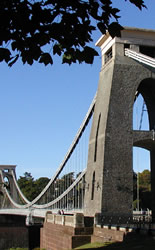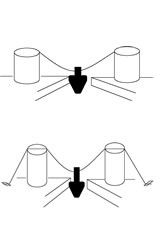Suspension Bridges
Suspension bridges have been used for thousands of years. They are built using two towers with chains or ropes suspending a walkway or road. They work in a very simple way.
Have you every tried to bend a cardboard tube? It’s pretty easy as the cardboard has no strength when you try to bend it. However, if you tried to crush it by pushing from either end you would find it much harder. This is because most materials can withstand much larger forces when they are squashed or compressed.

On a suspension bridge the two towers at either end are built of a material which can withstand large forces when compressed (squashed downwards).
Chains are strung between the towers and the deck (road) is suspended from these chains. If the chains were just attached to the towers at either end, the towers would be pulled towards the middle and collapse.
To stop this happening, the chains are anchored to the ground on the opposite side of the tower and the weight of the deck is transferred down through the towers at either end.
Because the weight of the deck is being transferred to the towers, suspension bridges can bridge much larger gaps than other types of bridges and modern suspension bridges can be more than one mile long!
Build your own Suspension Bridge
1. Take 2 cardboard tubes of the same size and a piece of string. 2. Tie or stick the string to the top of both cardboard tubes. 3. Place the cardboard tubes between two tables and then try hanging 100g weights from the middle. What happens? 4. Now take a longer piece of string and string it over the cardboard tubes but this time stick the string to the table on either side of the diagram. Add 100g weights to the middle of your bridge. What happens this time?
